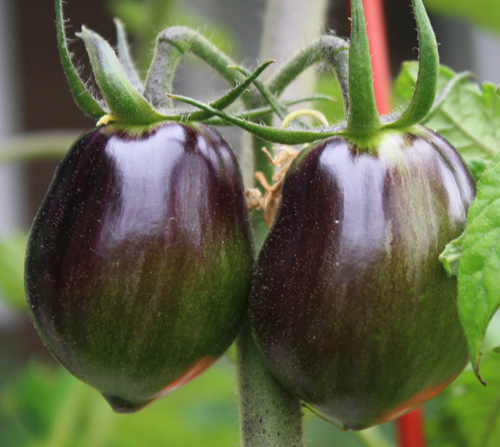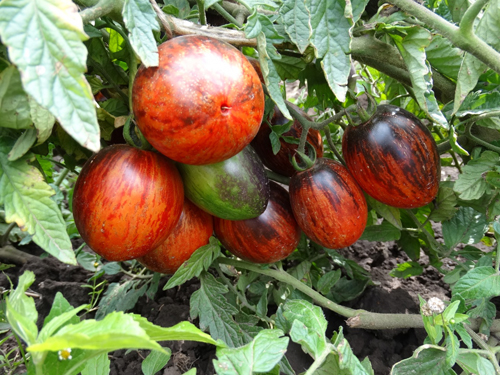Gargamel tomato variety
Breeders continue to amaze gardeners, giving the usual vegetables a completely unimaginable color. Take tomatoes. We are already accustomed to the unique taste of pink tomatoes, to the ideal shape of red-fruited ones, we tasted yellow, orange and even black, and here again a novelty - blue tomatoes. Among the bright representatives of these varieties, the variety called Gargamel is not lost. By the way, this is the name of a cartoon character, an evil sorcerer, the main sworn enemy of the Smurfs. The novelty belongs to the American selection, according to available information, its author is Phil Seneca. The species is not included in the State Register of Breeding Achievements of Russia, therefore there is no exact information about the regions and the method of cultivation. But there are numerous reviews of tomato growers who are already growing this beauty on their site. In their opinion, the exotic variety performs well both outdoors and indoors.

Description
The plant is indeterminate, tall, height from 1.5 to 2.0 meters. Indoors, the tomato shows good growth rates. The stem is of medium thickness. The foliage is weak, the shoot formation is moderate. Leaves are small, normal type, slightly wrinkled, slightly pubescent, dark green in color. The inflorescences are of a simple type. In each fruit cluster of Gargamel, about 3 - 6 tomatoes ripen. Inflorescences appear throughout the growing season. The peduncle is articulated.
The fruits of the variety are dense, smooth, plum-shaped, some have a slightly drawn nose, there are tomatoes with a blunt and slightly retracted top. The colors are amazing, even rather fantastic. Some tomato growers compare it to painted Easter eggs. The color of unripe fruits is violet-black. As it ripens, amazing metamorphoses take place with the color, and as a result, the ripe tomato becomes multi-colored. On its surface, stripes of orange, red, purple and even yellow colors are intricately intertwined. Most of all anthocyanin appears on the shoulders, where the color is the darkest, almost black. Interestingly, each tomato has its own unique color. The skin is glossy, very firm, even thick. The flesh of the Gargamel fruit on the cut has a bright red color, and it is evenly colored. In consistency, it is moderately dense, very fleshy, juicy, but not too watery. Ripe tomatoes taste sweet, but the taste cannot be called exotic. Typically, this is a real tomato flavor. But some tomato growers clarify that in waterlogged soil and with a lack of light, the taste is still low. Inside the tomato is multi-chambered, but the seed nests are small, there are many seeds. The mass of a tomato is 100 - 120 grams. According to reviews, the spread in weight is very large, the fruits can be 50 grams or 250 grams.

Variety characteristics
- In terms of ripening, the multi-colored "villain" Gargamel belongs to the mid-season. The first ripe tomatoes can be tasted 110 days after full sprouting. But there is information that fruits ripen earlier in greenhouses, after 90 days;
- there is no exact information about the yield. But the seed distributors and the vegetable growers themselves practically unanimously claim that the yield is excellent, because the plant's load with fruits is very high, and fruiting continues until the cold snap. Some sources give data about 4.5 - 5.0 kg per bush or 9.0 kg per 1 square meter;
- information about immunity is also scanty, but one can note good resistance of fruits to rot, tomato growers also speak of Gargamel's resistance to common diseases, such as late blight and cladosporium;
- durable peel not only protects tomatoes from cracking, but also serves as a guarantee of the integrity of the crop during long-term transportation;
- keeping quality is another strong point of the variety. If the storage standards are observed, the fruits retain their presentation for a month;

- the way of use is universal.They use amazing fruits in their natural form, for salads or for decorating dishes. The vegetable also demonstrates excellent qualities in conservation - it retains its shape after heat treatment and gives the seams an extraordinary flavor. Due to the high content of dry matter in the pulp, tomatoes are suitable for drying.
Agrotechnics
Of course, you need to grow Gargamel in a seedling way. The planting time is best calculated on your own. Sowing seeds is recommended to be carried out 60 - 65 days before the planned transplantation to a permanent place. Planting density - 3 plants per square meter. After transplanting, the tomatoes must be tied to a support or trellis. In order for the variety to be able to show the best result, they carry out pinching, and the bush is formed into 2 - 3 stems. The variety loves the sun, so plant outdoors in the lightest area. Due to this, more anthocyanins and sugars will accumulate in the fruits, from which the taste and appearance will only benefit. Watering is carried out in moderation, the soil should be in a moderately moist state. It is advisable to moisturize in the evening, avoiding the ingress of water on the leaves. To maintain the health of the crop, carry out preventive treatments.
Gargamel is still exotic for our beds, and given its novelty, there are few reviews about it. But those who grew a multicolored vegetable are simply delighted with it. The variety, of course, is primarily appreciated for its appearance, because not only in the garden, but also on the table, bright tomatoes look very elegant. And the variety is not deprived of productivity. The harvested crop is perfectly stored and suitable for processing. Separately, I would like to say about the great benefits of tomato, which contains not only anthocyanin, but also other useful substances that have a beneficial effect on the work of the cardiovascular system. There are no big complaints about the difficulties in leaving, the culture is generally unpretentious and requires conventional agricultural techniques. The only negative is the need to tie up and shape the plant.








